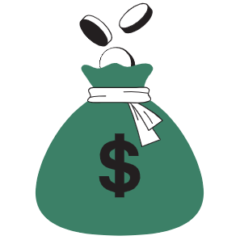Americans afraid of flying overwhelmingly took to the nation’s highways right after the September 11 terrorist attacks. But flying as we know is much, much safer than driving can ever be. Our odds of getting killed in a plane crash – one in a million. Our chances of dying in a car crash – one in five thousand1.
Or take a lawyer’s closing arguments. What is the jury most likely to remember most? How strong of a case the defense versus the prosecution makes right before the jury deliberates.
Here’s one more…what your boss remembers about your work influences to a large extent the performance review you’ll get. Unfair but unless they really work at it, it is generally true.
And what is your boss most likely to remember? Your recent impactful work.
These are all examples of recency bias. We give greater importance to recent events over historic ones because our brains like to take short-cuts. Thinking and number-crunching is hard.
But these attempts at taking shortcuts takes a terrible toll on our money because as they say, those who do not remember history are doomed to repeat it.
Take investors piling into hot investments du jour for example. I mean it feels natural to want to own what has done well lately and letting go of what hasn’t.
But in a portfolio of uncorrelated investments which is what you should strive to own, there will always be investments that suck. And sometimes they’ll suck for a long time.
But assuming you own investments that are bound to eventually recover, this is your chance to add to the holdings that are temporarily in the suck zone.
We won’t do that though. Because when an investment is not performing well, we assume it will continue to not perform well. Recency bias again.
They say elephants never forget. We must never forget. Never forget about the boom and bust investing strategies of Gerald Tsai, a mutual fund manager who rose to fame during the electronics boom of the 1960s.
But as it is with most booms, investor capital follows by the truckload which leads to a bunch of malinvestments which then eventually causes that boom to go bust. It did for Mr. Tsai as well and his investors suffered the consequences.
We should never forget about Garrett Van Wagoner, deemed the Warren Buffett of the Dot-com era. He ran his namesake Van Wagoner Emerging Growth fund that earned 66 percent a year for three straight years. It turned a single ten-thousand-dollar investment into forty-five thousand dollars.
But as is typical of most hot streaks that are often mere statistical anomalies, investors’ money follows by the truckload (again) but as always, much too late in the cycle. It did for Mr. Wagoner‘s fund as well with assets under management exploding 100 times in three short years to 190 billion dollars, as clear an example of recency bias as there can ever be.
Then the bubble burst. The tech-heavy NASDAQ fell from a peak of 5,000 points in March of 2000 to a low of 1,100 points by the October of 2002, a stunning 78 percent peak to trough decline for those keeping score. That is the nature of concentrated bets.
NASDAQ would continue to trade below that peak up until 2015. That is fifteen long years of waiting but we don’t remember that. It wasn’t all that bad had you continued to dollar-cost average into that investment, but no normal earthling ever would. And concentrated bets sometimes never recover.
The Van Wagoner Emerging Growth fund not only retraced the entire rise but when all was said and done, the fund earned a negative 8 percent a year from its inception in 1996 to its eventual demise in 2008. That is a cumulative loss of 65 percent of investors’ capital for the fund’s entire existence…before accounting for inflation of course.
But most investors, again due to recency bias, likely piled in at the peak so their losses were far, far worse.
We also must never forget about Ryan Jacob‘s Kinetic Internet Fund that he ran from 1997 to 1999. The fund earned 13 percent in 1997, 196 percent in 1998 and 216 percent in 1999, turning a single ten-thousand-dollar investment into $105,000 by the end of 1999.
Ryan left Kinetic to start his own fund, The Jacob Internet fund right at the peak of all things Dot-com. Investors’ money followed by the truckload (again) expecting that hot streak to continue.
But then the bubble burst. His new fund lost 79 percent in 2000, 56 percent in 2001 and 13 percent in 2002. That same $105,000 at the peak, had you followed him into his new fund, would be worth $8,300 at the bottom, a 92 percent peak-to-trough decline in three short years.
So, with that as a backdrop, how could we have not seen the train wreck that is Cathie Wood’s Ark Innovation fund? Or the egregiously valued tech stocks with catchy storylines that investors piled into just because this time was different?
This time is never different. It’ll take a generation of investors to forget about it and repeat the folly all over again. But repeat they will because of recency bias.
Some takeaways, hence…
- Never own a hot fund because by definition, it must be concentrated. And once that hot fund becomes cold, it’ll likely remain cold forever. Markets will recover but concentrated bets into bubble investments seldom do. If you must, buy it after it has cooled off, so you aren’t a victim of performance chasing. And no matter how compelling an argument the fund manager makes, think twice before overdoing it.
- Be mindful of what the stock market, one of the highest yielding of all investments as a category usually delivers over the long term. If you have an investment doing better than that, ask why. There is no free lunch anywhere, especially in the world of money.
- A business is a business. It must eventually adhere to the fundamentals of revenues and profits and cash flows, not some pie in the sky dream. So, when you are thinking of buying a stake in that business, try to find out why it is worth what it is worth. Because even if that dream were to be eventually realized, it does not mean you’ll get anything out of it if you paid too much for that business.
- And making investment decisions based on outcomes is a classic mistake we make. Always think about the process. If the process is not right, no amount of return matters. Because it will eventually blow up. Get the process right and things will fall in place.
Thank you for your time.
Cover image credit – Roger Brown, Pexels
1How Flying Today Is Safer Than At Any Time In The Past by Joanna Bailey & Riley Pickett, Simple Flying, September 8, 2022.

